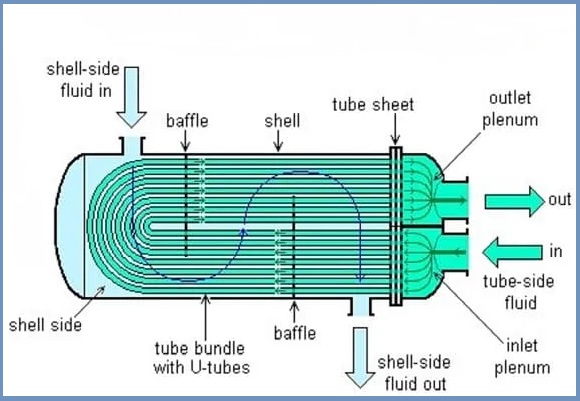A shell and tube heat exchanger is a mechanical device that uses a tube mounted in a cylindrical housing to exchange heat between two hydraulic fluids through thermal contact. Shell-and-tube heat exchangers are also known as shell and tube heat exchangers. As the name implies, this type of heat exchanger consists of an outer shell (a large pressure vessel) and a tube bundle. One liquid flows in the tube and the other liquid flows in the tube. This is a method of transferring heat from one fluid to another. The temperature of the liquid in the pipe and shell is different. This temperature difference acts as a driving force for exchanging temperatures between liquids. The
tube bundle can contain different types of tubes, such as tubes with vertical fins and plain tubes. These tubes can be placed in different configurations such as Floating head configuration, fixed tube configuration, and U-shaped tube configuration.

These types of heat exchangers are ideal for high-pressure applications. They are most commonly used in large chemical processes and oil refineries. These heat exchangers have low maintenance costs, low initial costs, stable performance, and a simple design. The shell and tube heat exchanger has a higher heat transfer coefficient than other heat exchangers. However, these heat exchangers require more space to install than plate heat exchangers with similar heat exchange capabilities.
Table of Contents
How Does Shell and Tube Heat Exchanger Work?
Shell and tube heat exchangers are simple and easy to operate. In the operation of this heat exchanger, one liquid moves through the tube while the other moves inside the housing.
As these fluids flow, they exchange heat with each other. This means that the hot liquid transfers its heat to the cold liquid. Thus, the cold liquid passes through the housing inlet nozzle and is discharged as a hot liquid through the outlet nozzle. Due to this heat transfer, the temperature of the other liquid at the outlet will be lower than at the inlet. Heat transfer of a defined tubular heat exchanger across the contact surface, as determined by the number of heat-conducting metal tubes. The fluid flow in this heat exchanger can be cross-flow or parallel.

The diagram above shows the outlet and inlet nozzle on the channel’s front manifold. This means that these heat exchangers have an even number of pipe segments. In this case, the channel-side output faucet is on the read header. As the number of turns of the tube increases, the heat transfer coefficient, and heat transfer rate increase. Baffles and jammers are installed in the housings and tubes to maximize fluid turbulence on the casing and tube walls.
Types of shell and tube heat exchangers
- Floating head exchanger
- Fixed tube sheet exchanger
- U-tube heat exchanger
Components of Shell and Tube Heat Exchanger
- Tie-rods
- Baffles
- Tube-Side Channel and Nozzles
- Shell and Shell-Side Nozzles
- Tubesheet
- Tubes
I have attached the pic below to better understand the components of shell and tube heat exchangers.

Key Advantages of Shell and Tube Heat Exchanger
- Shell and tube heat exchangers are less expensive than plate heat exchangers.
- These types of heat exchangers are easy to maintain and simple to construct.
- This is the best choice for high-pressure and temperature applications instead of plate heat exchangers.
- Tubular heat exchangers have a lower pressure drop than plate heat exchangers.
- Shell and tube heat exchangers are not as prone to clogging as plate heat exchangers.
- These exchangers have a stable and flexible design.
- There is no limit on size.
- These exchangers can be easily assembled and disassembled for cleaning, repair, and maintenance.
- You can make the pipe “double-walled” to reduce the chance that the wall fluid leaks into the shell side fluid (or vice versa).
- These types of heat exchangers offer more versatility than others.
